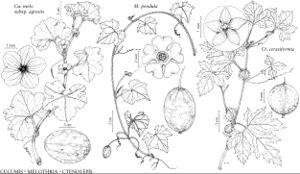Ctenolepis
in G. Bentham and J. D. Hooker, Gen. Pl. 1: 832. 1867.
| Taxon | Illustrator ⠉ | |
|---|---|---|
 | Cucumis sativus var. sativus Melothria pendula Ctenolepis cerasiformis | Yevonn Wilson-Ramsey Yevonn Wilson-Ramsey Yevonn Wilson-Ramsey |
Plants annual, monoecious, prostrate or spreading to climbing; stems glabrous or glabrate; roots not seen; tendrils unbranched. Leaves: petiole bracteate basally, bracts prominent, foliaceous, stipuliform, conduplicate; blade suborbiculate to broadly ovate-cordate [triangular], palmately (3–) 5–7-lobed, lobes obovate to ovate-oblong or elliptic, 2 lateral lobes deeply cleft, sinuses of main 3 lobes extending completely to base, margins entire or coarsely toothed, surfaces eglandular. Inflorescences: staminate flowers (3–) 5–10 (–20) in axillary racemes; pistillate flowers solitary, in same axils as staminate; bracts filiform [absent]. Flowers: hypanthium obconic to cylindric-campanulate; sepals 5, oblong-triangular; petals 5, distinct or nearly so, cream or light yellow to pale greenish, ovatelanceolate, 1–2 mm, glabrous, corolla rotate. Staminate flowers: stamens 3; filaments inserted near hypanthium rim, distinct; thecae distinct, short-oblong, connective narrow; pistillode absent. Pistillate flowers: ovary 3-locular, subglobose; ovules 1 per locule; style 1, columnar; stigmas 3, 2 (–3) -lobed; staminodes absent. Fruits berrylike, red, globose to depressed-globose, broadly ellipsoid-globose [depressed-turbinate], smooth, glabrous, indehiscent. Seeds (1–) 2 (–3), ovoid to ovoid-pyriform, compressed or planoconvex, not arillate, margins smooth, not bordered, surface smooth. x = 12.
Distribution
Introduced; Md., Asia, Africa
Discussion
Species 2 (1 in the flora).
The native range of Ctenolepis cerasiformis extends from tropical Africa to India and Pakistan. Ctenolepis garcinii (Burman f.) C. B. Clarke is endemic to Sri Lanka and peninsular India. A species sometimes identified as C. welwitschii (Hooker f.) Jafri, also with stipuliform bracts, has been maintained in its original position in the monospecific genus Dactyliandra Hooker f. (M. M. Bhandari and D. Singh 1964). Both genera are placed in tribe Melothrieae subtribe Trochomeriinae (C. Jeffrey 1990), along with one other genus, Trochomeria Hooker f. Differences among these genera––mostly in seed and anther morphology––appear to be no greater than variation within some other genera of the family.
Selected References
None.